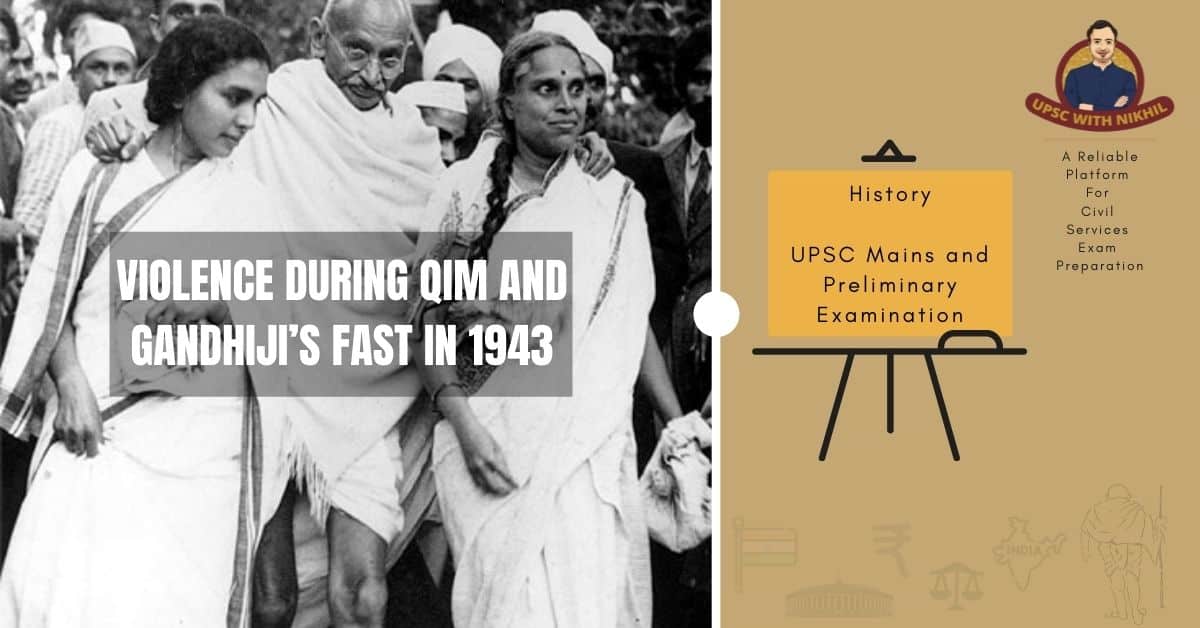Violence During Qim And Gandhiji’s Fast In 1943
How did the use of violence in 1942 fit into the nonviolence policy of Congress? For one thing, many people refused to use or sanction violent means, preferring instead to rely on the Congress's traditional weapons. However, many of those who used "violent means" in 1942, including many devout Gandhians, believed that the unusual circumstances justified their use.
• Many people believed that cutting telegraph wires and blowing up bridges were acceptable as long as no human lives were lost. Others admitted openly that they couldn't reconcile the violence they used or connived at with their nonviolence beliefs, but that they went ahead and did it anyway.
• Gandhiji refused to condemn popular violence because he saw it as a reaction to the state's much greater violence.
• This historic movement was significant in that it brought the demand for independence to the forefront of the national agenda. There could be no retreat after Quit India.
• Any future talks with the British government could only be about how power will be transferred. Independence was no longer a bargaining chip. After the war, this became abundantly clear.
• Gandhiji's release on medical grounds on May 6, 1944, rekindled political activity. The main form of Congress activity became constructive work, with a special emphasis on reorganising the Congress machinery. Congress committees were resurrected under new names, such as Congress Workers Assemblies or Representative Assemblies of Congressmen, rendering the ban on Congress committees ineffective.

• Workers were trained, membership drives were held, and funds were collected. The government viewed this reorganisation of the Congress under the guise of a constructive programme with grave reservations, seeing it as an attempt to rebuild Congress influence and organisation in the villages in preparation for the next round of struggle?
• The Viceroy kept a close eye on these developments, but no repressive action was planned, and his efforts were focused on formulating an offer (known as the Wavell Offer or the Simla Conference) that would avoid a conflict by reaching an agreement with the Congress before the War with Japan ended.
• In June 1945, the Congress leaders were released to attend the Simla Conference. That marked the end of the confrontational phase, which had lasted since August 1942.
GANDHIJI’S FAST 1943:
• A significant new development in February 1943 sparked a new burst of political activity. On the 10th of February, Gandhiji began a fast in prison. He announced that the fast would last 21 days. This was his response to the government, which had been pressuring him to condemn the people's violence during the Quit India Movement.
• Gandhiji not only refused to condemn the use of violence by the people, but he also held the government solely responsible. The people had been provoked by the state's "leonine violence," he claimed. And it was against this state violence, which included the unjustified detention of thousands of Congressmen, which Gandhiji vowed to register his protest by fasting, which was the only option available to him while incarcerated.
Public response: The public outpouring of support for the fast was immediate and overwhelming.' There were hartals, demonstrations, and strikes all over the country. Particularly active were the cities of Calcutta and Ahmedabad.
• Outsiders and inmates alike participated in sympathetic fasts. People travelled in secret to Poona to offer Satyagraha outside the Aga Khan Palace, where Gandhiji was imprisoned.
• Thousands of letters and telegrams were sent to the government from people from all walks of life, including students and youth, men in trade and commerce, lawyers, ordinary citizens, and labour organisations, demanding his release.
• Newspapers such as the Manchester Guardian, New Statesmen, Nation, News Chronicle, and Chicago Sun, as well as the British Communist Party, citizens of London and Manchester, the Women's International League, the Australian Council of Trade Unions, and the Ceylon State Council, demanded his release from across the seas.
Government response:
• The United States government exerted pressure as well. On the 19th and 20th of February, prominent men, politicians, and public figures gathered in Delhi for a Leaders' Conference.
• Gandhiji's release was demanded by all. Many people who were previously hostile to the Congress thought the government was going too far in its obstinacy.
• The resignation of three Indian members of the Viceroy's Executive Council, M.S. Aney, N.R. Sarkar, and H.P. Mody, who had supported the Government in its suppression of the 1942 movement but were not in the mood to be a party to Gandhiji's death, was the most serious blow to the Government's prestige.
• The Viceroy and his officials, on the other hand, were unmoved. They arrogantly refused to show any concern for Indian feelings, guided by Winston Churchill's statement to his Cabinet that "this our hour of triumph everywhere in the world was not the time to crawl before a miserable old man who had always been our enemy."
Gandhiji, on the other hand, got the better of his opponents and refused to die. The fast had accomplished exactly what it had set out to do. The public mood was lifted, anti-British sentiment was heightened, and political activity was made possible.
A symbolic act of defiance had sparked widespread opposition and exposed the government's tyranny to the entire world.' The Government was denied the moral justification it had been attempting to provide for its brutal repression of 1942, and it was clearly in the wrong.


